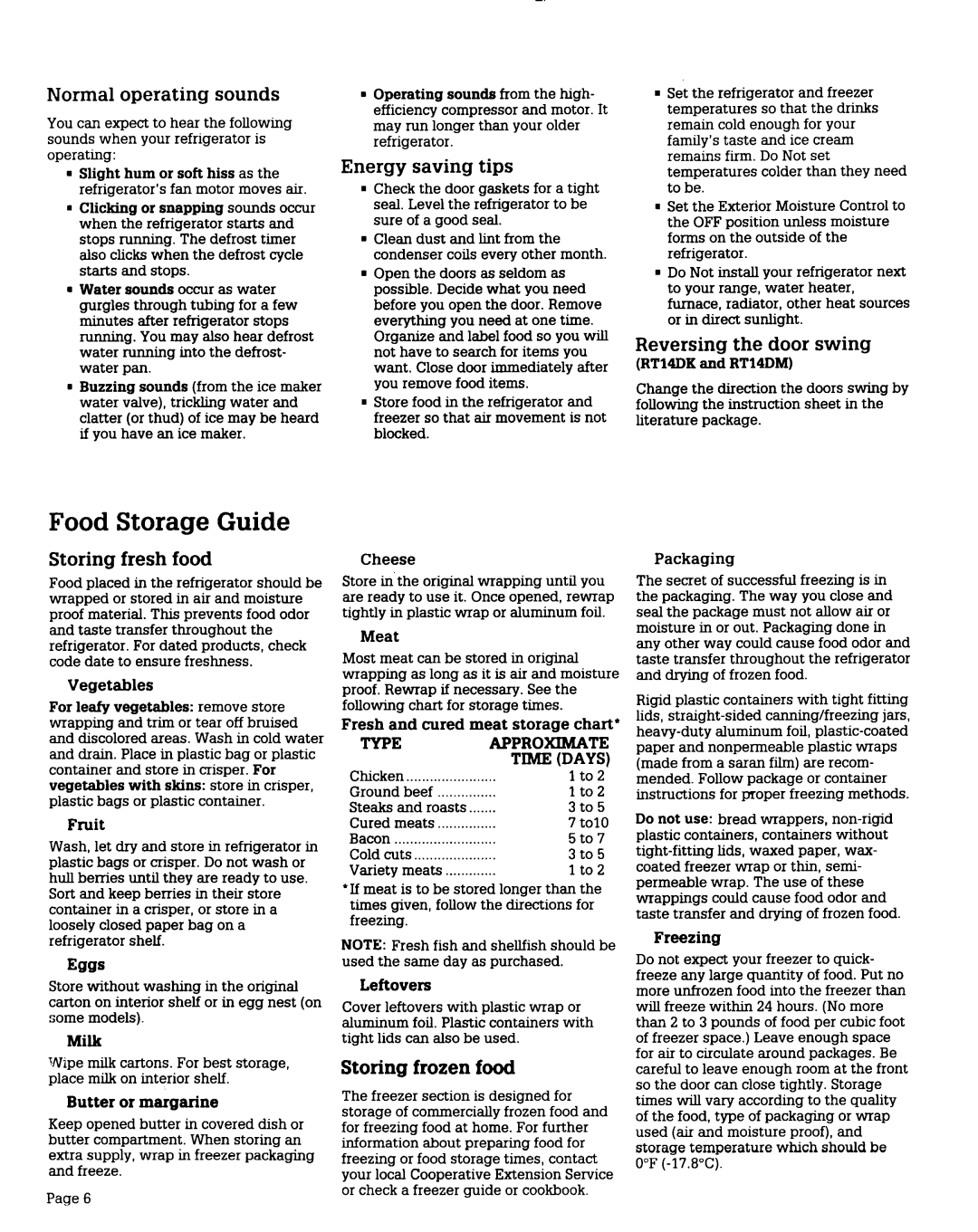
Normal operating sounds
You can expect to hear the following sounds when your refrigerator is operating:
. Slight hum or soft hiss as the refrigerator’s fan motor moves air.
n Clicking or snapping sounds occur when the refrigerator starts and stops running. The defrost timer also clicks when the defrost cycle starts and stops.
. Water sounds occur as water gurgles through tubing for a few minutes after refrigerator stops running. You may also hear defrost water running into the defrost- water pan.
IBuzzing sounds (from the ice maker water valve), trickling water and clatter (or thud) of ice may be heard if you have an ice maker.
Food Storage Guide
Storing fresh food
Food placed in the refrigerator should be wrapped or stored in air and moisture proof material. This prevents food odor and taste transfer throughout the refrigerator. For dated products, check code date to ensure freshness.
Vegetables
For leafy vegetables: remove store wrapping and trim or tear off bruised and discolored areas. Wash in cold water and drain. Place in plastic bag or plastic container and store in crisper. For vegetables with skins: store in crisper, plastic bags or plastic container.
Fruit
Wash, let dry and store in refrigerator in plastic bags or crisper. Do not wash or hull berries until they are ready to use. Sort and keep berries in their store container in a crisper, or store in a loosely closed paper bag on a refrigerator shelf.
Eggs
Store without washing in the original carton on interior shelf or in egg nest (on some models).
Milk
Wipe milk cartons. For best storage, place milk on interior shelf.
Butter or margarine
Keep opened butter in covered dish or butter compartment. When storing an extra supply, wrap in freezer packaging and freeze.
Page 6
. Operating sounds from the high- efficiency compressor and motor. It may run longer than your older refrigerator.
Energy saving tips
Check the door gaskets for a tight seal. Level the refrigerator to be sure of a good seal.
Clean dust and lint from the condenser coils every other month.
Open the doors as seldom as possible. Decide what you need before you open the door. Remove everything you need at one time. Organize and label food so you will not have to search for items you want. Close door immediately after you remove food items.
Store food in the refrigerator and freezer so that air movement is not blocked.
Cheese
Store in the original wrapping until you are ready to use it. Once opened, rewrap tightly in plastic wrap or aluminum foil.
Meat
Most meat can be stored in original wrapping as long as it is air and moisture proof. Rewrap if necessary. See the following chart for storage times.
Fresh and cured meat storage chart*
APPROXIMATE TIME (DAYS)
Chicken |
| 1 to 2 |
Ground beef | . . | 1 to 2 |
Steaks and roasts | 3 to 5 | |
Cured meats | . . . . | 7 to10 |
Bacon | 5 to 7 | |
Cold cuts | . | 3 to 5 |
Variety meats | 1 to 2 | |
l If meat is to be stored longer than the times given, follow the directions for freezing.
NOTE: Fresh fish and shellfish should be used the same day as purchased.
Leftovers
Cover leftovers with plastic wrap or aluminum foil. Plastic containers with tight lids can also be used.
Storing frozen food
The freezer section is designed for storage of commercially frozen food and for freezing food at home. For further information about preparing food for freezing or food storage times, contact your local Cooperative Extension Service or check a freezer guide or cookbook.
Set the refrigerator and freezer temperatures so that the drinks remain cold enough for your family’s taste and ice cream remains firm. Do Not set temperatures colder than they need to be.
Set the Exterior Moisture Control to the OFF position unless moisture forms on the outside of the refrigerator.
Do Not install your refrigerator next to your range, water heater, furnace, radiator, other heat sources or in direct sunlight.
Reversing the door swing
(RTl4DK and RTlQDM)
Change the direction the doors swing by following the instruction sheet in the literature package.
Packaging
The secret of successful freezing is in the packaging. The way you close and seal the package must not allow air or moisture in or out. Packaging done in any other way could cause food odor and taste transfer throughout the refrigerator and drying of frozen food.
Rigid plastic containers with tight fitting lids,
Do not use: bread wrappers,
Freezing
Do not expect your freezer to quick- freeze any large quantity of food. Put no more unfrozen food into the freezer than will freeze within 24 hours. (No more than 2 to 3 pounds of food per cubic foot of freezer space.) Leave enough space for air to circulate around packages. Be careful to leave enough room at the front so the door can close tightly. Storage times will vary according to the quality of the food, type of packaging or wrap used (air and moisture proof), and storage temperature which should be 0°F
